TOP 8 best electric planers: review, price, pros and cons
When working with wood, you cannot do without a tool such as an electric planer. This is an electric analogue of a manual device for processing timber or other wooden surfaces.However, it works faster. Such a convenient tool will never be superfluous in your home workshop.
The content of the article:
What to look for when choosing
The electric planer is structurally complex, so a number of criteria should be taken into account before purchasing. Electric tools are indispensable when working with wooden materials and are suitable for:
- Primary processing of wooden surfaces. Depending on the technical characteristics of the tool, you can plan both soft types of trees (spruce, larch, pine, poplar, linden and willow) and hard species (oak, maple, ash, walnut, pear and apple).
- Planing. In addition to the initial processing of wooden surfaces, the machine is used for sanding, and various types of knives are used to create texture on the wood.
- Sampling quarter. This is a groove on the edge of a piece of wood. Made with several passes of the tool. But there are some models that have an attachment for quickly and comfortably cutting out this quarter.
- Chamfer. A popular task that requires an electric planer. Especially for this purpose, grooves of different sizes are made on the sole of the tool, which are used to remove the chamfer.
The operation of this tool is implemented as follows: the drum on which the knives are mounted moves due to an electric drive, cutting off excess parts from wooden surfaces. The advantage of an electric tool over a manual one is control of the cutting depth. Some models have height, vertical and diagonal adjustments. But, basically, the maximum thickness of the cut layer is 2 mm.Also, devices from some companies have the ability to process wood with restrictions. This additional function is to reduce waste and more rational use of raw materials.
The main differences between an electric tool and its manual counterpart:
- Knives. With a hand plane they are simple. In electric ones, it is a drum with separately purchased plates.
- Speed. The electric drive allows you to work with the tool faster, increasing productivity.
- Less stress. When working with an electric planer, you do not need to exert the same physical effort as with a hand tool.
- Design. An electric planer is more complex than a hand tool, so repairs and maintenance are more expensive.
- Types of jobs. An electric planer can do more work on wooden surfaces.
- Convenient waste disposal. Wood shavings and sawdust that are formed during operation in an electrical appliance are removed through a bag on the side of the tool, and not through the hole at the top.
- Price. Hand tools are cheaper than their electric counterparts.
- Safety. It is safer to use a hand plane than an electric one. Work and effort are controlled. The second type is a complex device that operates at high speeds. Has a lot of weight. This makes it difficult to use.
- Stationary type of work. Electric planers are installed on the work surface. It is more convenient to work, especially when processing small parts.
If you need a high-quality and reliable tool, you need to determine the direction of application. By type of use, electric planers are produced:
- Household. Electric planer for small jobs at home. Typically, the power of this type does not exceed 600 W, and the thickness of the layer removed from the surface is 2.5 mm.In addition, they are lightweight and have low power consumption.
- Professional. The power of such electric planers is almost 2 times higher than that of household ones, up to 1100 W. They are for complex work. The thickness of the cut layer is more than 4 mm. An obvious drawback, as with many professional tools, is its significant weight (up to 9 kg).
- Manual. A type of electric planer for processing small surfaces. With additional functions, unlike the electric counterpart.
- Stationary. This type of electric planer has fastenings. They are fixed motionless on the work surface. At the same time, visually it looks like an ordinary electric planer, but turned upside down. Suitable for processing small or medium-sized parts that are easier to hold in your hands than to fix on a workbench and handle with a heavy tool.
Electric planers contain knives or cutting plates. The following characteristics are important in the tool:
- Usage. Cutting plates for electric planers are disposable and reusable. If necessary, purchase additional consumables.
- Type. Knives are single-sided and double-sided. They have 1 or 2 cutting sides.
- Material. The cutting plates come in 2 metals. These are hardened steel (strength, for reusable products) and tungsten carbide (short-lived metal). Knives made from the latter cannot be sharpened and are disposable.
- Size. There are 3 main types of cutting insert sizes: small (35mm), standard or medium (82mm) and large (110mm). In addition, knives are available in different thicknesses.
- Form. The electric planer comes with classic straight knives. But you can also purchase separately rounded ones. They are used to create smooth transitions on the surface.Figured knives are used to achieve the effect of antiquity or additional texture.
In construction and online stores, electric planers are sold with a mains power supply with a wire (you will need to purchase an extension cord for operation). However, there are also more convenient models that come with a built-in battery and are wireless. The last type of instrument has the following features:
- the absence of mains power allows you to work in a room with a high level of air humidity;
- no dependence on power sources;
- The cost of battery models is higher than that of wired ones.
When choosing a reliable tool, you need to carefully study the technical characteristics, for what specific work it will be needed, and what additional functions it should have. What parameters should you pay attention to:
- Power. The difference in the value of this characteristic in a household and professional device is almost 2 times. Therefore, before purchasing, it is determined what type of work the tool will be needed for and how large-scale it will be.
- Knives. For popular models, the cutting blade width is mainly 82 and 100 mm. However, depending on the type of work, you will need to additionally purchase cutting plates or opt for a model with accessories.
- Sole. This item consists of 2 parts. On high-quality and expensive devices, the back part is made of cast aluminum material. However, it is the sole that is defective in different models. Common cases are loose fasteners or lack of parallelism.
- Speed. The speed and processing of materials directly depends on this parameter. On average, it ranges from 12,000 to 18,000 rpm.
- Ergonomics.The ease of use of a tool is an important criterion when choosing. It is impossible to work long and efficiently in discomfort.
- Thickness of the removed layer. On average, the depth is 2 mm. But there are models with adjustment, where this value reaches 4 mm. There are also types of electric tools where the planing thickness starts from zero.
- Additional surface protection. When the device is turned off, the drum with cutting plates, due to the speed of rotation, does not immediately stop, but continues to rotate for some time. It is important not to spoil the already treated surface. To do this, on certain models, either a hinged casing (covers the side of the drum) or a support heel (a spring element that covers the back) is installed.
- Weight. For convenient work with the tool it should average 3-4 kg. With a higher value, your hands will quickly get tired.
- Safety of use. When purchasing, pay attention to the location of the operating buttons so that using the electric planer is convenient and safe. Check for additional blockers. This element is not found in all models, but its presence will be a significant advantage.
- Additional functionality. A big plus will be the brake, which will quickly stop the drum with cutting plates when the device is turned off. In addition, there are models with the following additional features: built-in ruler and side limiter, smooth descent and maintenance of one rpm value.
When purchasing such a complex device, you should expect that sooner or later you will have to encounter some problems with the operation of the device. Of course, if the user does not have the knowledge to repair equipment, it is recommended to contact a service center.That is why it is better to buy such devices with a guarantee from the store that sells this product or from the manufacturer. Possible problems with the operation of an electric planer can be divided into 2 types:
- related to the operation of the electric motor;
- with other parts of the device.
Electric motor problems are solved mainly by professional repair or replacement at a service center, or by purchasing a new tool if the problem is unprofitable.
Problems with electric planer parts include:
- Brush wear. One is washed first. Signs of a problem can be: loss of engine power and increase in noise level during operation, ozone smell and the appearance of sparks under the ventilation grille.
- Wiring problems. Associated with frequent twisting, bending of the reins, as well as insufficiently tight contact with the outlet. This may result in burning. Such problems can be corrected by replacing either the wire or part of it, or the plug of the device.
- Mechanical problems. Such problems include: belt breakage or stretching. It is easy to carry out this repair yourself. The main thing is to choose the right spare part for replacement. Frequent bearing failures. Just like the belt, you can fix this problem yourself by replacing the old elements with new ones.
Of course, if you have doubts about the ability to perform high-quality repairs yourself, it is better to contact a specialized service center. There are a number of malfunctions, the elimination of which is a warranty case:
- blade wear;
- occurrence of sparking;
- problems with the drive belt;
- problems with adjusting the device.
Interesting for you! TOP 12 best electric and manual planes: review, pros and cons, price.
Rating of the best electric planers
Now there is a large selection of these devices on the construction tools market. When choosing from a huge rating, you should rely not only on a number of nuances and your own needs, but also on reviews of the best electric planers from masters. Reviews from real users are taken into account. The list of the best electric planers for the home includes not only well-known brands, but also devices from less popular companies. The latter budget ones, however, are not inferior in quality to inexpensive competitors.
Makita 0810KP
Japanese brand manufacturer of electric and gasoline tools, a leader in the manufacture of high-quality devices. The electric planer from this company is no exception. It is suitable for a small home workshop. In addition to its pleasant appearance, it is ergonomic. They are easy and pleasant to work with. The weight of the electric planer is a little more than 3 kg, so they work for a long time without feeling any discomfort.
With a power of 850 W and a speed of 12,000 rpm, the sound during operation is not very annoying to the ear. Planing thickness reaches 4 mm. This is a great advantage for household tools. This model is available in 4 versions, differing in power (850 and 1050 W), speed (12000 and 16000 rpm) and additional functions (soft start, maintaining the set speed). The price of this device in online construction stores is 21-23 thousand rubles.
Advantages:
- thickness of the treated layer;
- acceptable noise level during operation;
- high performance.
Flaws:
- high price.
DeWalt 680DW
The famous brand of electric tools from the USA is known for its quality devices. The electric planer of this company has a high speed of rotation (15,000 rpm) with a low engine power of 600 W.This provides good performance in the home workshop when performing small jobs, including hardwood. Cutting depth is up to 2.5 mm, which is an average value for this segment of electric planers. The device comes with carbide cutting inserts, which are enough for long-term use. The price of this tool is about 17 thousand rubles.
Advantages:
- quality knives included;
- low noise level during operation;
- ergonomics.
Flaws:
- There is no speed control.
Metabo 82HO
Convenient, ergonomic and reliable electric planer. This instrument is popular when used outside the city and in villages. It has a relatively low power of 620 W. Does not overload the power grid even during long periods of work. The maximum planing depth is 2.6 mm, and the width of the knives is 82 mm. At the same time, the speed is high - 17,000 rpm.
The device is convenient to operate, and there is a special lock button on the case. Using an electric planer, you can easily perform the following work: cutting quarters up to 9 mm and chamfering. The vibration level is acceptable for comfortable performance of long work without severe fatigue in the hands. However, the device is noisy, so it is recommended to purchase additional protection. The price of the tool on popular marketplaces is about 17 thousand rubles.
Advantages:
- possibility of sampling quarters;
- ergonomics;
- small power and low electricity consumption.
Flaws:
- high noise level.
BOSCH 6500GHO
An electric planer from a well-known German company is presented by the manufacturer as a professional tool. However, it is a good device for the home workshop.An average power of 650 W, a speed of 16,500 rpm and a weight of 2.8 kg allow you to comfortably and productively carry out small planing at home. But such an electric planer is not suitable for large and large-scale tasks.
A special sharpening device will come in handy many times for reusable knives. The disadvantages include a hole for removing chips. The kit does not include a special adapter for a vacuum cleaner. It will have to be purchased separately. And if you don’t connect the waste drain, the sawdust will fly to the sides, complicating the work. The average cost of this tool is 11 thousand rubles.
Advantages:
- ergonomics;
- ease of control;
- light weight;
- additional device for sharpening knives.
Flaws:
- inconvenient waste disposal;
- lack of adapter for connecting a vacuum cleaner;
- inaccurate assembly of some elements.
RYOBI 7582EPN
An inexpensive yet high-quality electric power planer from a Japanese manufacturer of construction power tools. The power is slightly above average at 750 W and the speed of 16,000 rpm, as well as the thickness of the processed layer of 2 mm, are suitable for both small jobs at home and larger-scale tasks.
Convenient two-way waste ejection for right-handed and left-handed people to use the device productively. However, the special hole quickly becomes clogged. It is necessary to periodically stop work and clean it. The price for this tool is small, 6,500 rubles.
Advantages:
- ergonomics;
- low cost;
- high power for this type of device;
- two-way waste emission.
Flaws:
- rapid suction of waste removal;
- some elements are sloppily assembled.
Interskol 82R
Of course, the advantage of this electric planer, which is why many people prefer it for purchase in a home workshop, is the balance between price and quality. The user receives an excellent device with a power of 710 W, a speed of 14,000 rpm, and a maximum thickness of the processed layer of 2 mm.
Of course, if you compare this electric planer with competitors like BOSCH or Metabo, the figures are small, but this factor increases the service life of the cutting plates. At high speeds, there is a high risk of damage or breakage of knives on hard knots or nails. An electric planer can easily be called noisy. Its level during operation is above 100 dB, so when purchasing this particular model, it is worth additionally purchasing noise-canceling headphones and/or earplugs. The price of this device is about 5,500 rubles.
Advantages:
- price-quality correspondence;
- low cost;
- high noise level.
Flaws:
- low speed;
- difficult and inconvenient replacement of knives.
Fiolent 82Р3
Powerful budget electric planer. The manufacturer positions it as an ideal tool for working with hard wood. The technical specifications confirm this. The device has a high power of 1050 W and a speed of 15,000 rpm. The electric planer is produced in Russia using Italian equipment, as additionally indicated by the manufacturer. In addition, it provides warranty service for a period of 36 months. The price of the device on popular marketplaces is from 6,000 to 8,000 rubles.
Advantages:
- suitable for working with hard wood;
- high power;
- long work without overheating.
Flaws:
- inconvenient location of control buttons on the body;
- frequent cases of defects in the form of skewed soles.
DECKER 712KW
An inexpensive electric planer from an American power tools company, primarily for the home. Technical characteristics of the device: power - 650 W, planing depth - up to 2 mm and high speed - 17,000 rpm. This electric planer is suitable for a small home workshop.
There is no outlet on the body to the vacuum cleaner for collecting waste. But the kit includes an adapter for connecting another element. Unfortunately, the device often has defects. There are loose and non-parallel soles. It is this part that you should first pay attention to when purchasing. The price for such an electric planer starts at 4,000 rubles, which is acceptable.
Advantages:
- low price;
- high speed of revolutions;
- The kit includes an adapter for connecting a vacuum cleaner for waste.
Flaws:
- frequent cases of defective soles;
- rapid clogging of the chip discharge tube;
- minimum equipment.
Having carefully studied which electric planer is best to buy for a home workshop, the pattern becomes clear. If the user plans to use the tool often, even for small jobs, then it is better to overpay and buy an expensive but high-quality copy. Or save money and accept the shortcomings, some of which are quite acceptable, while others will cause discomfort. Which company is better to choose is determined individually.
Which power tool do you use to plan boards and cut quarters? Share the link on social networks and bookmark the article.
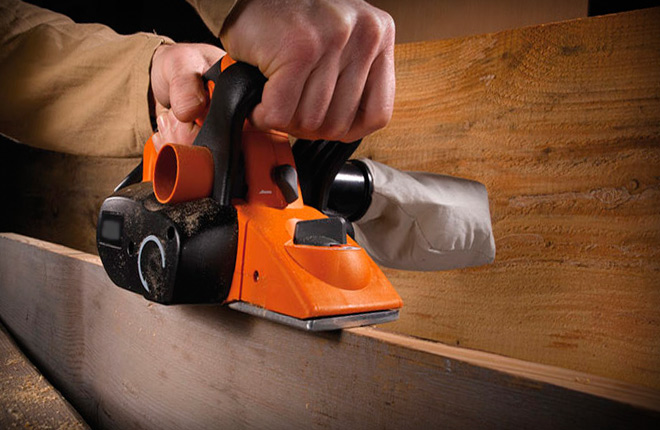

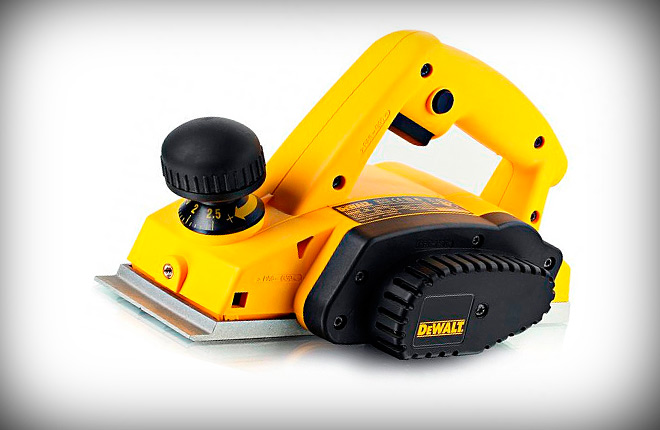

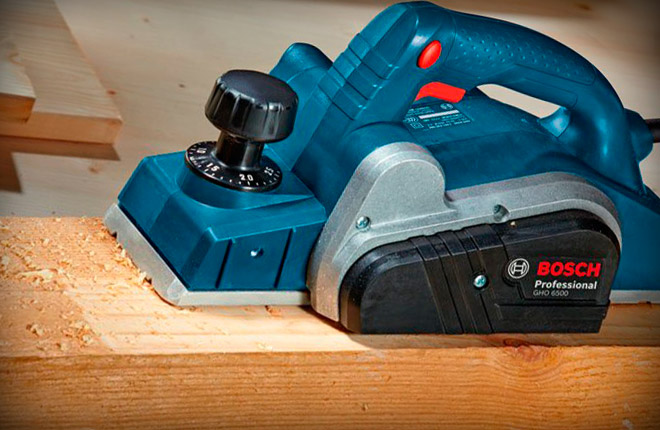

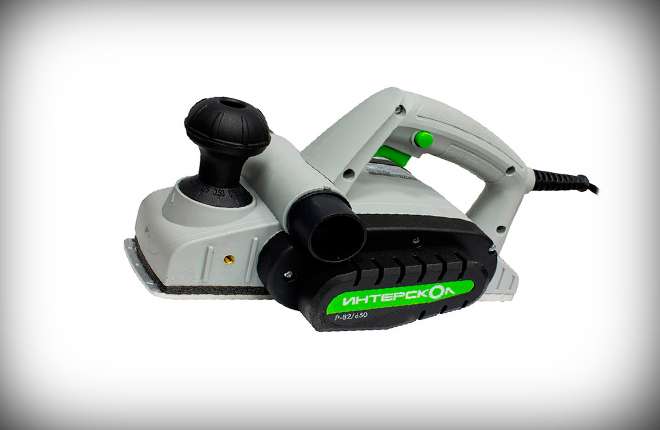
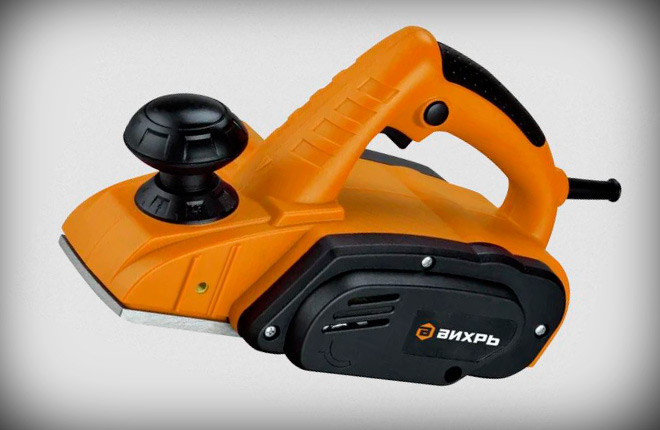
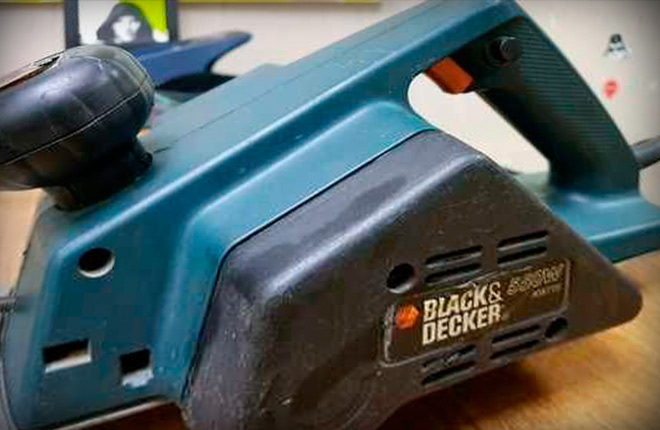




At first I worked with Fiolent, but it quickly broke down (irretrievably). I bought BOSCH, no problems. Powerful, reliable.
I bought RYOBI without knives included. And then I took Italian plates from hardened steel, double-sided sharpening.
Interskol can be taken for homework. But, if you plan window frames and other logs on a weekly basis, you won’t find a better job than Bosch.